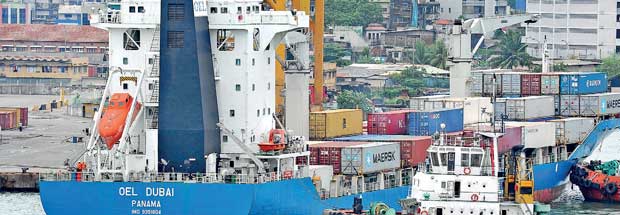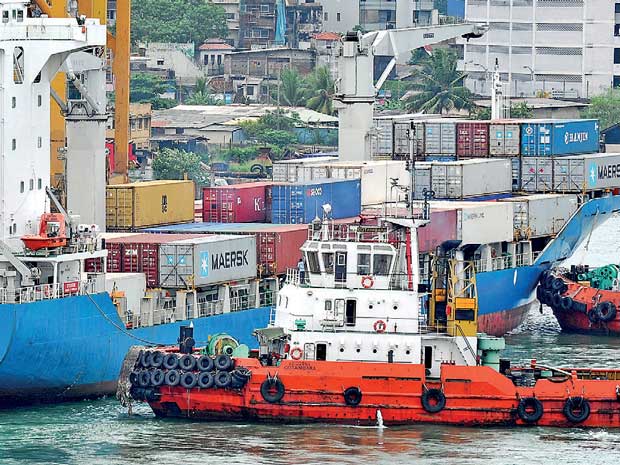Reply To:
Name - Reply Comment
Last Updated : 2024-04-23 12:32:00
 Sri Lanka’s trading pattern has been such that the two largest markets for its exports are the United States of America (USA) and United Kingdom (UK). Regionally, Europe is the single largest market for Sri Lanka’s exports.
Sri Lanka’s trading pattern has been such that the two largest markets for its exports are the United States of America (USA) and United Kingdom (UK). Regionally, Europe is the single largest market for Sri Lanka’s exports.
In terms of imports, Asian countries (such as China, India, Singapore, the United Arab Emirates (UAE), Japan, Malaysia, Thailand, Taiwan and Hong Kong) are the largest sources of imports to Sri Lanka. Consequently, Sri Lanka has a trade surplus with many western countries while having trade deficits with most Asian countries.
Trade between Sri Lanka and India are centuries old, both formal and informal. In the present millennium, bilateral trade between Sri Lanka and India has soared, only partly induced by the free trade agreement (FTA) between the two countries, which came into operation in 2000.
India has been the single largest trading partner of Sri Lanka for a very long time, especially since 1977. However, China has overtaken India as the single largest trading partner of Sri Lanka for the very first time in 2016.
Whilst the total trade value between Sri Lanka and China amounted to US $ 4,426 (imports from China US $ 4,215 million + exports to China US $ 211 million) in 2016, it was US $ 4,369 million between Sri Lanka and India (imports from India US $ 3,815 million + exports to India US $ 554 million). (See tables) As a corollary, Sri Lanka’s trade deficit with China is the single largest; amounting to US $ 4,004 million in 2016, followed by with India amounting to US $ 3,261 million in 2016.
The trade deficit of Sri Lanka with China is expected to continue to rise in the next decade and beyond because of the large-scale public investments by the Chinese state-owned companies such as China Harbour Engineering Company Ltd (CHEC), China State Construction Engineering Corporation (CSCEC), et al.
The CHEC is financing and undertaking the construction of the Colombo International Financial City/Centre (CIFC, which was formerly known as the Colombo Port City) by reclaiming land (269 hectares or 660 acres) from the sea by the southern side of the Colombo port. This is the single largest foreign direct investment Sri Lanka has ever received. This mega infrastructure project is expected to cost about US $ 1.4 billion and expected to attract US $ 13 billion worth of investments over the 30-year period of the project cycle. (Economy Next, May 5, 2017, http://www.colomboportcity.lk/press/2017/05/05/chinas-us$15bn-reclaimed-city-in-sri-lanka-targets-investors-from-the-west-india-middle-east.html accessed on August 5, 2017)

The bulk of the machinery, hardware and raw materials for the aforementioned mega projects are imported from China. Moreover, a substantial number of technical, skilled and unskilled labour for these projects is also from China.
A total of US $ 3.75 billion worth of loans has been disbursed by China to Sri Lanka between 2010 and 2014. (External Resources Department, 2014: 17) China has hardly provided any grants to Sri Lanka to date. Similarly, imports from India include goods imported for the Government of India-funded infrastructure and other projects across the country. India has provided total grants worth over US $ 200 million between 2010 and 2014 and over US $ 1 billion as loans between 2005 and 2014. (High Commission of India in Sri Lanka, 2014: 10-11)
Roughly around 70 percent of Indian aids to Sri Lanka are loans and around 30 percent outright grants in recent years (2010-2016). The former are repayable but the latter are not.
Sri Lanka’s exports in the past five years (2012-2016) in terms of top 10 destinations in terms of value are catalogued in Table 1. Accordingly, India is the third largest destination for Sri Lanka’s exports, accounting for a five-year average of 5.6 percent of Sri Lanka’s total exports between 2012 and 2016. The USA was the largest destination accounting for almost 25.0 percent (average) for the period 2012-2016. The UK is the second largest destination for Sri Lanka’s exports accounting for about 10 percent of the total exports of Sri Lanka during 2012-2016. China accounts for just 1.8 percent of the total exports of Sri Lanka during 2012-2016 (10th largest destination). (See Table 1)
China has emerged as the single largest source of imports to Sri Lanka in 2016 accounting for 21.7 percent of the total imports of Sri Lanka worth US $ 4,215 million. However, on average for the five-year period 2012-2016, annual imports from China amounted to US $ 3,408 million, accounting for almost 18 percent of the total imports of Sri Lanka. (See Table 2)
India was the single largest source of imports to Sri Lanka during the five-year period between 2012 and 2016, averaging US $ 3,783 million per annum, accounting for almost 20 percent of the total imports of Sri Lanka. However, in 2016 India was relegated to the second position (after China) in terms of the source of imports, accounting for19.7 of the total imports of Sri Lanka, amounting to the value of US $ 3,815 million.
Singapore (averaging US $ 1,373 million per annum between 2012 and 2016), the UAE (averaging US $ 1,298 million per annum between 2012 and 2016) and Japan (averaging US $ 900 million per annum between 2012 and 2016) are the other three largest sources of imports into Sri Lanka. (See Table 2)

Sri Lanka has had a trade deficit with India ever since independence. Only during the Second World War time Sri Lanka had a trade surplus with India as the latter had to import food, primary products and raw materials from the former to feed the war effort. The trade deficit of Sri Lanka has been increasing in absolute terms during almost every year since 1977. The ever-growing trade deficit with India has been an irritant in Indo-Lanka relations in the same way as India’s relations with other South Asian neighbouring countries. Some may argue that bilateral trade liberalisations (like the FTA) and trade facilitations (such as the proposed bridge) would result in trade diversion rather than trade creation. That is, according to this argument, bilateral liberalisations/facilitations may divert trade from other more competitive sources of import rather than creating additional trade between any two countries. However, studies on Indo-Lanka trade have shown that India is the main/major source of goods that are imported to Sri Lanka (for instance) because it is more competitive (least cost) than other sources (See, for example, Sarvananthan, 2001: 35-37).
Trade with other South Asian countries
Sri Lanka’s trade with the members of the South Asian Association for Regional Cooperation (SAARC) countries is meagre. Pakistan is the second largest trade partner of Sri Lanka within South Asia, followed by the Maldives and Bangladesh (exports only). There is hardly any trade (both exports and imports) takes place between Sri Lanka and Afghanistan, Bhutan and Nepal. The latter three are landlocked countries whose trade passes through neighbouring countries such as India and Pakistan.
The annual average two-way trade between Sri Lanka and Pakistan between 2012 and 2016 was US $ 397 million (exports to Pakistan US $ 74 million + imports from Pakistan US $ 322 million). The annual average two-way trade between Sri Lanka and the Maldives was just US $ 104 million (exports to the Maldives US $ 74 million + imports from the Maldives US $ 30 million) between 2012 and 2016. (See Tables 3 and 4) While with the Maldives Sri Lanka has a trade surplus, with Pakistan it has a trade deficit. The annual average total two-way trade between Sri Lanka and the SAARC countries amounted to US $ 4,992 million between 2012 and 2016; exports to SAARC countries average US $ 827 million per annum and imports from SAARC countries average US $ 4,165 million per annum. (See Tables 3 and 4) Whilst India accounted for 71 percent of the annual average exports of Sri Lanka to all eight SAARC countries between 2012 and 2016, India accounted for 91 percent of annual average imports of Sri Lanka from all SAARC countries between the same period.
While too much noise is being made by certain businesses and of course, certain politicians about the growing trade deficit with India (China could be also bashed in the not so distant future), there is not much discussion about the imports from Singapore and the UAE. Singapore has been the second largest source of imports after India for a long period of time. However, the rapidly growing imports from the UAE are only about a decade long with the ascendancy of the Rajapaksa regime in 2005.
To begin with, Singapore and the UAE are not producers of most items imported into Sri Lanka. However, many importers in Sri Lanka source their imports from Singapore and the UAE because the bulk of the black monies of Sri Lankan businesses, rich individual citizens and of course politicians, is stashed away in secure bank accounts in these two countries. It is these black monies that are whitened for the import trade into Sri Lanka.
Moreover, the informal foreign currency market is also extensively used by the importers of goods from Singapore and the UAE into Sri Lanka. Traditionally, crony businesses, individuals and politicians aligned with the United National Party (UNP) have used Singapore to store their ill-gotten money and wealth. In the last 12 years, crony businesses, individuals and politicians aligned with the Sri Lanka Freedom Party (SLFP) have effectively used the UAE to store their ill-gotten money and wealth.
Therefore, businesses and politicians in Sri Lanka instead of crying foul about the growing trade deficit with India (and China), should request the government to investigate the sources of financing of the ever growing imports from Singapore and the UAE, which would pay rich dividends towards combating corrupting and taming the black economy of Sri Lanka and their inextricable entanglement with the governance of this country.
(Muttukrishna Sarvananthan (Ph.D. Wales, M.Sc. Bristol, M.Sc. Salford, B.A. (Hons) Delhi) is a development economist by profession and Principal Researcher of the Point Pedro Institute of Development, Point Pedro, Northern Province and the author of ‘An Assessment of Contraband Trade and Capital between India and Sri Lanka’ published by Kumaran Book House (Colombo and Madras) in 2001.
Email: sarvi@pointpedro.org)


Add comment
Comments will be edited (grammar, spelling and slang) and authorized at the discretion of Daily Mirror online. The website also has the right not to publish selected comments.
Reply To:
Name - Reply Comment
On March 26, a couple arriving from Thailand was arrested with 88 live animal
According to villagers from Naula-Moragolla out of 105 families 80 can afford
Is the situation in Sri Lanka so grim that locals harbour hope that they coul
A recent post on social media revealed that three purple-faced langurs near t

21 Apr 2024